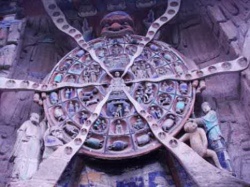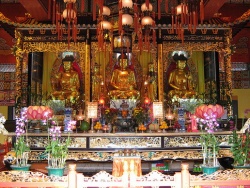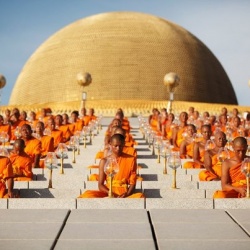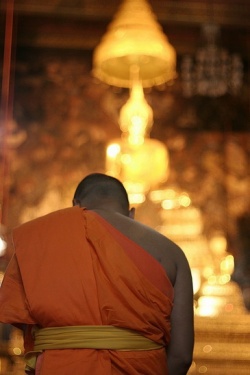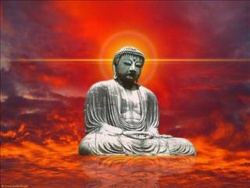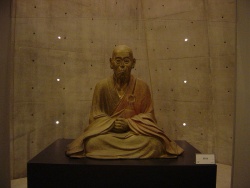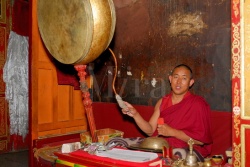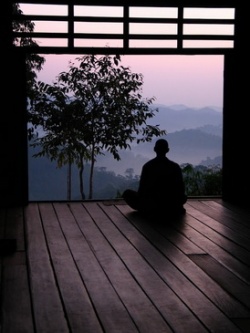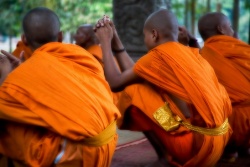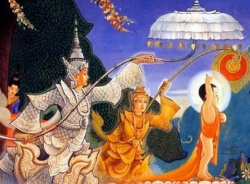Creating Buddhist rituals for Beginners Subscribe to Buddhist rituals for Beginners
I think it's necessary to explain some basic meanings of buddhist rituals, esp. for those beginners who are into buddhism.
In making offerings to the Buddha, most buddhist will probably know you need to burn 3 incensee two palms together and then make 3 kowtows. In modern times, some buddhist temples have reduced to 1 incense partly due to reasons of environmental protection. However, in most dharma services, the tradition is still 3 incense.
Not all buddhist know the significant meaning about the 3 incenses together and 3 kowtows. Let me explain.
3 Incense
In Mahayana Buddhist practice, the 3 incense represents "Precepts incense" (戒香), "Concentration Incense" (定香)and "Wisdom Incense" (慧香). It coincides with Mahayana Buddhist's spiritual practice towards enlightenment, particularly the 3 learning 三學:Precepts (戒), Concentration (定), Wisdom (慧). Precepts are laid down to cut off all evils, to prevent bad karma from rising, to purify bad karma, in order for one's Bodhicitta to develop and for good karma to arise. If a person's mind is full of impediments and bad karma, it will continue to create obstacle to a person's spiritual practice, it will continue to create trouble and sufferings for him. With such obstacles and bad karma in a person, a person will not be able to subdue his own mind, let alone develop concentration. Therefore, beginners in buddhism typically focus on practising precepts to prevent bad karma from rising, to cut off all evil, to allow all good karma to rise up. And without creating any more bad karma, a bodhicitta pure mind can progress towards the next stage (particular in meditation) such as concentration (at the intermediate level) and the last stage wisdom (at the more advanced level) as the highest level of full enlightenment.
Palms Together (合十)
Holding two palms together. The Chinese buddhist term for this is called "He Shi 合十" (literally "10 together") represents putting 10 fingers together. Typically, it's angled about 45 degree to the body. Palms together is not just a typical ritual in making offerings to the Buddha, it's also a typical practice of greeting amongst buddhists, to venerables, to buddhist masters etc.
It has an internal effect of subduing one's internal mind and creates an impression of peace and humility. When we feel nervous, trouble, angry, holding the palms together allow us to feel internal peace, serenity and mind concentration. Although it looks simple, it is known in Buddhism to able to subdue a troubled mind.
Palms on top of each other (操手)
This involves putting two palms horizontally on top of each other and known in Chinese as "Chao Shou 操手 " In common practice, the right palm should be on top of the left palm, with both palms facing top. The two palms should be put around the front of abdomen. The position should be in a relaxed position.
This is a common practice in dharma services, sometimes in chanting, but usually after chanting esp. when listening to venerable's talk (known as Kai Shi 開示 in Chinese). It has an effect of remaining calm and relaxation.
Ritual of Finger tips (triangular position/shape) on head (問訊)
The Chinese buddhist term for this ritual is called "Wen Xun 問訊"
First of all, put your two palms together but focus your eye attention on your finger tips. Then bow 90 degree together (without kneeling down) to the Buddha with your two palms together. However when you come up, you need to change your palm signs. Basically, the thumb and 2nd finger of each left and right hand palm should form a triangular position/shape). The rests of other fingers should laid one after each other.
This palm position signifies the meaning of a lotus flower waiting to be blossom (it's shaped like a lotus flower), just like offering flowers to the Buddha and Bodhisttava.
When you rise up, put through your chest and rise your triangular palm signs on top of your head to your eye brow, but not touching the forehead. This presents offering to the buddha and bodhisattva to the top and is a form of respect, reverence and humbleness.
After this, slowly raise your palm back to the chest position and then change it to the palms together position.
3 kowtows (拜佛/禮佛)
The entire ritual of kowtow in Chinese Buddhism is known as "bai fo 拜佛/li fo禮佛" (pay respect to Buddha/offering to Buddha)
Kowtows (磕頭) involve palms together, two legs slowly together (forming the Chinese word 八 shape). The distance between the legs should be around 5 cm. One then slowly kneel onto the ground. The right hand should touch the ground first followed by the left hand, then let your hand slide towards the front. The palm should face down initially and your knee should not move. Slowly let your head your head and hands down (palms facing down) touching the ground. The distance between your hands should be around 15 cm. Your forehead should touch the ground.
Then, flip your palms up and lay it align with the floor. This is known as 頭面接足禮( ritual of palm head accepting the legs). When you are getting up, you need to flip your palms back to face the ground. After that, you can get up.
In common practice, it's 3 kowtows to the Buddha.
The 3 kowtows to the Buddha typically means the following:
1st kowtow - pay respect to the Buddha
2nd kowtow - seek refuge in Buddhism and express the wish to learn the dharma from the Buddha
3rd kowtow - repentence for one's own wrong-doing, past bad karma and vow never to commit any more evils.
When doing the 3 kowtows to the Buddha, it actually means paying homage to the Buddha, to seek refuge in triple gems, to learn the dharma (teachings of the Buddha) and to do repentence service.
In many occasion, kowtow to the Buddha (拜佛) can be one time, esp. during chanting services.
The 3 Kowtows are often accompanied by Ritual of Finger tips (triangular position) on head (問訊)
Dedicating Merits (回向)
Many buddhists do not know the significance of dedicating merits. It's known as "Hui Xiang 回向" in Chinese. In chanting sutra, buddha's name, it's important to dedicate merits to other sentient beings, to your family members, to your friends, to those who are sufferings, and to all sentient beings.
Dedicating merits is a form of transferring the merits that you've gained through good dharma practice to all sentient beings. It allows one to progress towards bodhicitta and nirvana. One can also dedicate the good merits that you've gained through doing good to those who had passed away. It can actually create karmic affinity to the person you dedicate the merits to, esp. if you pray the person suffering from sickness hoping him to get better.
Dedicating merits usually come in the form of a verse where one chants after chanting. A common verse is as follow:
愿以此功德,庄严佛净土。
上报四重恩,下济三途苦。
若有见闻者,悉发菩提心。
尽此一报身, 同生极乐国
Translation:
May I dedicate my good merits, to dignifiy the buddha pureland
To repay the 4 kindness on top, to save the 3 sufferings below
If any person hear this, may one vow a mind of bodhicitta
With this, I repay my body, to be born together in the pureland
Some verse can simply be:
愿以此功德, 回向給 ....(name of person)
May I dedicate this good merits to ....name of person
Dedicating merits can be categorized into common (一般回向), personal (個人回向), great(大回向), mass(普回向), and final dedication(縂回向). In most common practice, dedicating merits typically involve great and mass dedication. Common dedication of merits is usually used for common merits. Personal dedication is individual dedication of merits to a particular person, to past debtors, karmic haters of you, to diminish disaster, to someone who is suffering etc. Great dedication involves massing all the powers of compassion and vows together to dedicate for all the sentient beings. Mass dedication basically follows the dedication of Samanthabra Bodhsittava 普賢菩薩 (symbolizing great action) to all sentient beings. Final dedication is the last stage of dedication, usually done at the end of big dharma services and sometimes held at the end of year in buddhist temples.
Just to further explain the following text:
上报四重恩,下济三途苦。
To repay the 4 kindness on top, to save the 3 sufferings below. This is a common text at the end of Mahayana sutra chanting, esp. in dedicating merits.
What does 四重恩 (4 kindness/favour) and 三途苦 (3 sufferings) mean?
In Chinese Mahayana buddhism, the 四重恩 "4 kindness" (favours) refers to the kindness that you receive in your realm of humans (i.e. in your present life). They result in what you're today:
1. Parent's Kindness 父母恩
2. Country's Kindness 國家恩
3. All Sentient Being's Kindness 衆生恩
2. Triple Gem (Buddha, Dharma, Sangha)'s kindness 三寳恩
Mahayana Buddhist typically tries to practise gratitude (thankfulness) 感恩 by repaying back the 4 kindness received. For parents, it's a practice of filial piety. For country, it's a practice of loyalty. For all sentient beings, it's a practice of compassion. For triple gem, it's a practice of devotion and respect.
The 3 sufferings 三途苦 refers to the sufferings in the 3 lower realms of existence such as realm of animals, realm of hungry ghost, realm of hell. Mahayana buddhist typically also tries to practise helping the sentient beings in these 3 realms relieve their sufferings, as their sufferings are even greater and more painful than that in the realm of humans. It's part of the compassion practice in the buddhist daily life.
Many dharma services in temples generally serve the purposes of relieving the sufferings in the lower realms (or in fact the 6 realms of existence). One example of a dharma service held in many buddhist temples that help to relieve the sufferings in the realms of hell and hungry ghost is the Ksitigarbha Bodhisattva Dharma Service (地藏王菩薩法會)- usually held during the Hungry ghost festivals (Ullambama festival). Another big major dharma service held once a year in many buddhist temples is the Dharma Service of Land and Water 水陸法會 (in fact it's the largest dharma service in Chinese mahayana Buddhism). They are done to relieve the sufferings for the sentient beings in all realms of existence.
佛门礼仪~礼佛 (offering to buddha)
佛门礼仪~合十 (palms together)
佛门礼仪~操手 (palms on top of each other)
佛门礼仪~问讯 (triangular shape on head)
佛门礼仪~长跪 (kneeling down)
佛门礼仪~上香 (incense)
佛门礼仪~请经 (request for sutra)
佛门礼仪~念珠 (chanting buddhist beads)
佛门礼仪~海青 (how to wear haiqing, the dress for buddhist)
佛门礼仪~缦衣 (how to wear Manyi, the robe for 5 precepts)
The buddhist ritual for incense 上香 is different from that of Taoism. The following Chinese video is a good education video for illustrating proper ways of holding the incense for Buddhism:
佛門禮儀-上香(incense offering)
I learn something from this video, esp. when my temple uses horizontal incense 卧香
佛門禮儀-禮拜三拜 (3 kowtows)
Usually, it's one time 问讯 (wenxun) followed by 3 kowtows and then 问讯 (wenxun) again.
The following two Chinese videos teach you the proper ritual/,manners on how to sit down when wearing Haiqing and Manyi
佛門禮儀-海青坐之威儀 (Sitting Manners/Rituals when wearing Haiqing)
佛門禮儀-縵衣坐之威儀 (Sitting manners/rituals when wearing Manyi)
Here is one Chinese video teaching you how to walk up and down when wearing Haiqing.
佛門禮儀-上下樓梯 (Walking up and down the stairs when wearing Haiqing)

